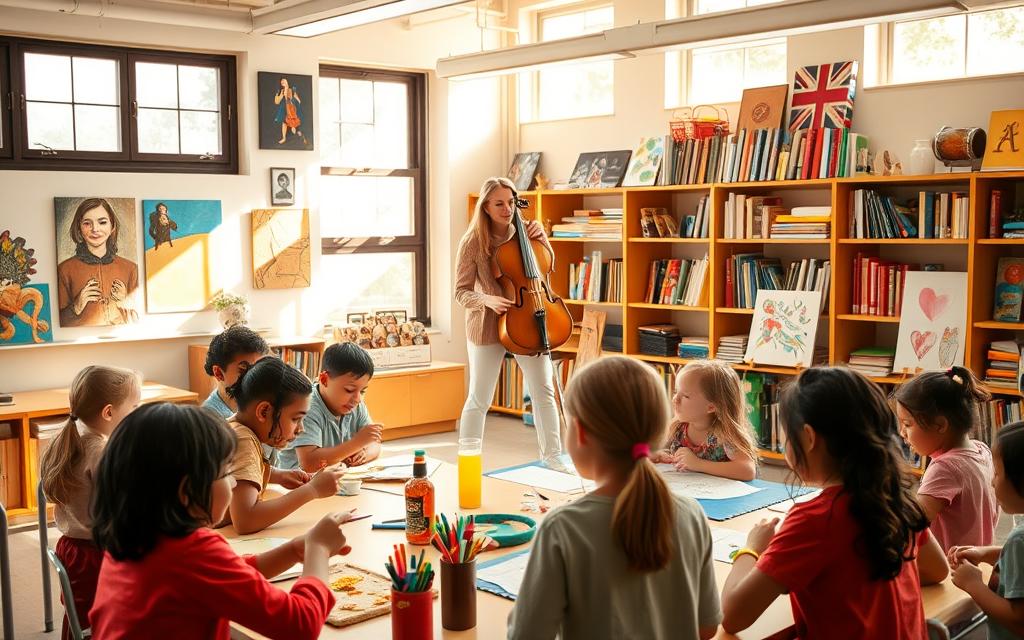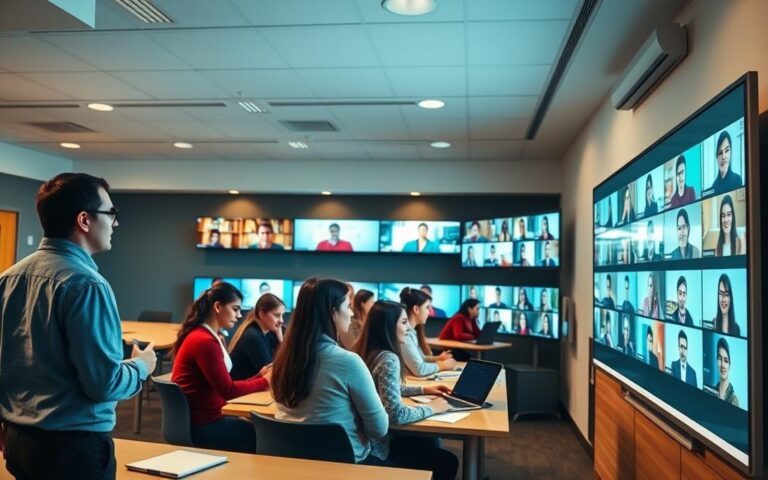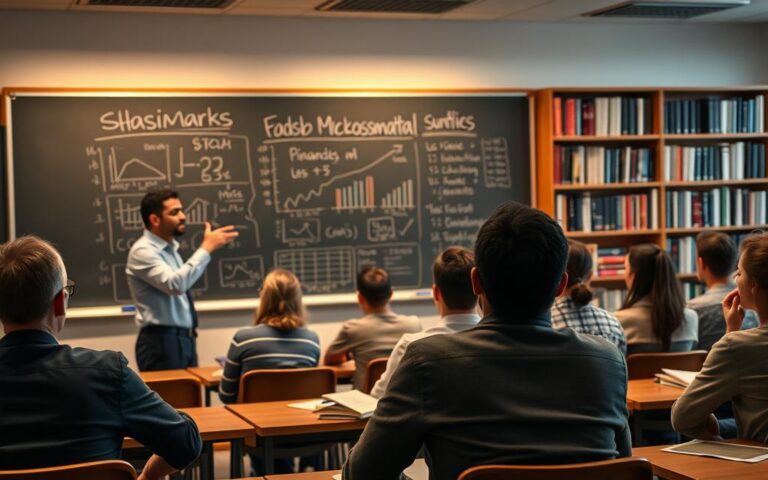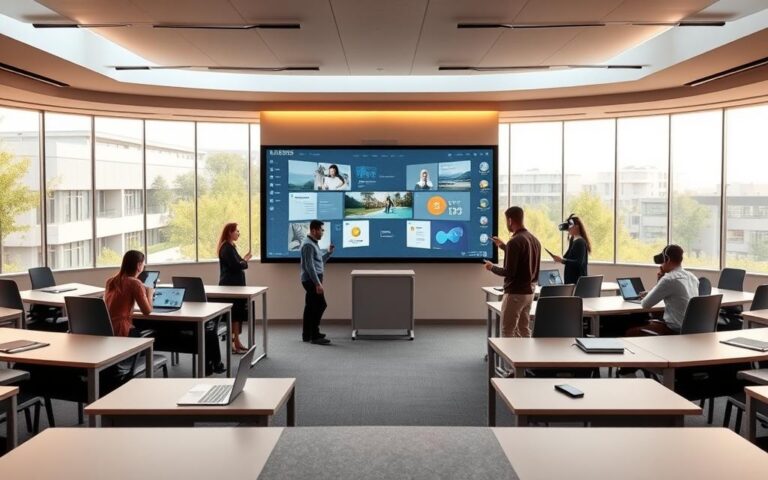Arts and music programs boost creativity and help students succeed in the long run. Studies by the National Endowment for the Arts and Americans for the Arts show a link. They found that arts education leads to better grades, more graduates, and more college-goers.
Visual arts like painting and digital art improve observation and problem-solving. Performing arts, such as theater and dance, enhance imagination and confidence. Music education, including playing instruments and singing, sharpens pattern recognition and discipline.
This introduction is for U.S. K–12 educators, school leaders, parents, advocates, and community leaders. They seek evidence and practical ideas. Later, we’ll share policy and program advice, funding tips, and ways to work with the community to make arts education more accessible.
The Importance of Arts Education in Schools
Arts programs change how students think, feel, and connect with others. Studies from Johns Hopkins and Harvard show music and arts boost brain skills. Early arts education helps with learning basics fast.
Teenagers who do arts learn to solve complex problems. Schools that focus on arts education help students learn in different ways. This strengthens their brains and builds discipline through practice.
Benefits for Cognitive Development
Research shows music and visual arts improve brain functions. Kids who play piano or paint get better at remembering and recognizing patterns. Arts in the classroom improve reading and math skills.
Young children who do arts learn language better. Teenagers who do arts improve their problem-solving skills.
Enhancing Social Skills
Arts like music and theater teach important social skills. Working together in arts projects teaches teamwork and leadership. Schools with strong arts programs have students who feel more connected.
In class, arts projects teach students to work together. They learn to communicate and take responsibility, skills needed for jobs and community life.
Fostering Emotional Intelligence
Arts give students a safe way to express their feelings. Drama and visual arts help students understand and manage their emotions. Arts in schools can reduce bad behavior and improve mental health.
Teachers use journals and feedback to see how students grow emotionally. They help students understand and control their feelings.
Current Trends in Arts Education
Schools and community centers are changing how students learn art. New tools and fresh approaches make creative work more accessible. These trends shape arts integration in education and expand visual arts education, music education, dance education, and arts education programs across grade levels.
Integrating Technology
Digital audio workstations like Ableton and GarageBand let students compose and record music easily. Music notation tools like MuseScore and Sibelius help learners score pieces and share arrangements.
Tablets and stylus tools, like the iPad Pro with Procreate or Wacom devices, change visual arts education in class. Virtual reality experiences open new possibilities for immersive art and dance studies. Online portfolios let young artists publish and showcase work to families and peers.
These benefits require teacher training and reliable bandwidth. Schools must plan for devices, technical support, and professional development so arts education programs reach every student.
Collaborative Art Projects
Cross-disciplinary projects now link classrooms and neighborhoods. Murals bring students, teachers, and local artists together to transform public space. School musicals and district theater festivals draw broad participation and build pride.
Interdisciplinary STEAM projects combine science, math, and art for real-world problem solving. Project-based learning in these settings improves teamwork and civic engagement. City mural initiatives and regional theater programs show how collaboration boosts community ties and student confidence.
Emphasis on Diversity and Inclusion
Curricula are shifting toward culturally responsive content that reflects student backgrounds. Programs include indigenous arts, Latinx, African American, Asian American, and immigrant traditions in classwork and performances.
Efforts to remove participation barriers use adapted instruments, sliding-scale fees, and inclusive teaching methods. Schools add supports for multilingual learners and students with disabilities so music education, dance education, and visual arts education feel welcoming to all.
These trends guide modern arts education programs as schools aim to be more equitable, engaging, and future-ready.
The Role of Music Programs in Education
Music programs help students develop important skills. They improve focus, memory, and discipline. These programs are key to a strong arts education and support other performing arts.
Studies show music education boosts math scores and reading skills. Students who study music are more likely to go to and stay in college. Skills like pattern recognition and timing help with standardized tests.
Impact on Academic Performance
Music practice leads to better grades and test scores. Rhythm exercises help with math sequencing. Ear training improves reading and language skills.
Building Teamwork and Collaboration
Ensembles teach students to work together. They learn to balance roles and follow directions. This builds leadership and teamwork skills.
Understanding Musical Theory
Music theory lessons teach structure and patterns. Early grades learn basic notation and rhythm. Later grades cover harmony and composition.
Combining music education with performing arts education is beneficial. Schools that focus on both build confident, cooperative learners. These students excel in other subjects and beyond.
Arts Education and Career Opportunities
Arts education opens many career doors. Students build portfolios, improve audition skills, and make professional connections. These skills lead to jobs in theater, galleries, studios, and media.
Students can choose from conservatories, arts-focused high schools, college degrees, or vocational apprenticeships. Each path offers unique opportunities.
Pathways to Creative Professions
Conservatories and arts-focused high schools provide intense training. College degrees like BFA and BM offer technical skills and industry exposure. Internships give students real-world experience.
Scholarships and programs like the National YoungArts Foundation support talent. Apprenticeships help artists develop skills and make industry contacts.
Importance of a Diverse Skill Set
Employers want artists who are creative and skilled in communication, project management, and entrepreneurship. Learning digital media, audio engineering, marketing, or teaching can open more doors.
Building a strong portfolio, preparing for auditions, and networking are key. Arts education curricula often include career prep. This teaches contract basics, self-promotion, and client relations.
Arts in Non-Creative Industries
Arts skills are valuable in tech, healthcare, business, and education. Design thinking and visual literacy are useful in UX design. Theater programs improve patient communication in healthcare.
Advertising firms, product teams, and nonprofits need creative problem solvers. Arts education prepares graduates to meet these needs with innovation, empathy, and clear presentation.
Community Arts Programs: Bridging Gaps
Community arts programs offer a place for all ages to learn and share creativity. They go beyond school walls, bringing arts to neighborhoods without resources. Local partnerships help make this happen.
These programs come in many forms. After-school groups and community theaters offer regular chances to perform. Art centers have drop-in studios and weekend workshops. Mobile arts programs bring arts to parks and libraries.
Local Initiatives and Their Impact
Groups like Young Audiences Arts for Learning and regional arts councils partner with schools. They run residencies and workshops. These efforts show real benefits: better attendance, fewer discipline problems, and more civic involvement among youth.
These programs track their success through attendance, surveys, and performance results. Schools see better engagement when arts are part of learning. Lessons that connect to music, theater, or visual arts improve across subjects.
Engaging Underserved Populations
Reaching low-income and rural students needs flexible models. Free or low-cost programs help. Instrument loans and transportation support make it easier for families without easy access.
Working with libraries, community centers, and health clinics helps reach more people. Grant-funded programs often see more students from underrepresented groups. Inclusive programs, like bilingual instruction and adaptive arts, open arts education to more.
Promoting Cultural Heritage
Community projects keep local traditions alive. They include folk music, traditional dance, and craft arts. Festivals and oral history projects help document these practices and connect young with elders.
Artist residencies and working with cultural bearers add authenticity and respect. These efforts strengthen identity and ties between generations. They also enrich arts education and community programs.
| Program Type | Typical Partners | Key Benefits |
|---|---|---|
| After-school ensembles | Schools, community orchestras, Young Audiences | Musical skill-building, improved attendance, teamwork |
| Community theater | Local theaters, drama educators, arts councils | Confidence, public speaking, civic engagement |
| Mobile arts programs | Libraries, parks departments, grant funders | Access for remote areas, flexible scheduling, arts exposure |
| Cultural festivals & residencies | Tribal groups, immigrant associations, cultural centers | Heritage preservation, intergenerational learning, community pride |
| Instrument loan & adaptive classes | Nonprofits, school districts, disability advocates | Equity in participation, inclusive performing arts education, sustained enrollment |
The Psychological Benefits of Arts Engagement
Classrooms and community studios are great for mental health. Studies show arts help reduce stress and boost emotional growth. Schools with arts programs offer safe spaces for students to express feelings and improve focus.
Reducing Stress and Anxiety
Research links music, dance, and visual arts to lower stress and anxiety. Art therapy in schools helps kids who have faced trauma. Programs in places like Los Angeles and Boston show better moods and fewer behavioral problems.
Teachers can use art to help students relax. Short creative breaks or rhythmic exercises can calm a busy day.
Encouraging Mindfulness
Art-making improves focus and being present. Activities like drawing and rhythmic practice require attention. These mirror mindfulness practices used in social-emotional learning.
Combining SEL with studio work helps students focus better. Reflective prompts after art sessions help students notice their thoughts and feelings.
Boosting Self-Esteem
Creating art, performing, and sharing work boosts confidence. Public performances and recitals build resilience. Feedback and gallery shows celebrate achievements and teach constructive criticism.
Studies from places like Columbia University show arts improve self-confidence, even in tough neighborhoods. Arts programs offer chances to master skills and be recognized.
Arts Education in Early Childhood
Early years are crucial for learning and growth. Music, instruments, movement, and painting in preschool and kindergarten boost language, fine motor skills, and pattern recognition. Studies show arts education in early years has lasting benefits.
Foundations for Future Learning
Sing-alongs, finger painting, and rhythm games help children connect sounds to words. These activities also improve hand-eye coordination and small muscle control for writing. Pattern-based art tasks help with sequencing and early math.
Research links early arts exposure to better reading readiness and attention. Activities for different ages include simple songs for toddlers, guided crafts for three- to four-year-olds, and music circles for four- to five-year-olds.
The Role of Play in Creativity
Play-based learning focuses on choice and exploration. Open-ended materials spark imagination, while dramatic play and sensory art stations let children test ideas. Music-and-movement circles combine rhythm with social interaction.
Guided play balances child-led discovery with adult support. Teachers can ask open questions, offer materials, and model new vocabulary. This boosts curiosity and creative confidence.
Parental Involvement in Early Arts
Families extend learning through simple routines like morning songs and drawing together. Visiting library storytimes with art activities also helps. Shared projects and workshops strengthen family bonds and reinforce arts education at home.
Parental modeling encourages sustained participation and builds vocabulary related to emotions and creativity. Community resources include Head Start arts, local arts councils, and library programs for family arts events.
| Age Range | Suggested Activities | Developmental Targets |
|---|---|---|
| 12–24 months | Rhythm clapping, finger painting, sound play | Listening skills, grasp and release, basic vocal imitation |
| 2–3 years | Movement songs, large-muscle dance, collage with safe scissors | Gross motor coordination, color naming, early cutting skills |
| 3–4 years | Dramatic play centers, guided painting, instrument exploration | Role-taking, fine motor control, rhythm recognition |
| 4–5 years | Music-and-movement circles, collaborative murals, pattern-making games | Social collaboration, sequencing, preliteracy vocabulary |
The Impact of Arts on Academic Engagement
Arts education makes school more interesting by connecting creativity to learning goals. When teachers mix arts with subjects like math and science, students see how ideas are connected. Schools that use arts in education find lessons that stick with students.
Enhancing Learning through Creativity
Using theater to learn about history, visual arts for science, and songwriting for literacy makes learning fun. These methods help students remember what they learn. Studies show that creative learning helps students retain information better.
Teachers can create arts-based lesson plans that meet standards. For example, a science class might draw plant anatomy and then act out a scene about ecosystems. This approach helps teachers see if students have learned and keeps lessons focused.
Real-World Applications of Arts
Community projects turn classroom work into real results. Students can design for city parks, curate exhibitions, or perform on campus. These projects help students build portfolios and connect with the community.
Instead of just tests, schools use exhibitions and performances to assess learning. Rubrics that include real-world tasks show how arts education prepares students for the workforce. This approach highlights the value of arts education.
Student Participation and Motivation
Schools with strong arts programs often see better attendance and fewer dropouts. When students choose their projects and share them with others, they stay engaged. This is crucial for students at risk of falling behind.
Keep track of how often students participate and celebrate their arts achievements. This makes the value of arts education clear to everyone. It helps keep support for programs that inspire students.
Funding and Support for Arts Programs
Arts education thrives with strong funding and support. Federal grants, state funds, private gifts, and corporate partnerships all help. They keep arts programs running and shape the curriculum in schools.
Government Initiatives
National Endowment for the Arts grants and Department of Education awards fund arts projects. State arts agencies give grants and offer incentives for arts-rich plans. This helps schools plan for arts education.
Title I funds support arts in high-need schools tied to academic goals. Schools need to match funds, plan budgets, and show results. They must also follow rules to keep funding.
Massachusetts and California show how state policies boost arts education. Clear standards and dedicated funds help districts plan for the long term.
Non-Profit Contributions
Groups like Americans for the Arts and local foundations support arts programs. They place teaching artists in schools and help teachers grow. Non-profits also run residencies and after-school programs.
Partnerships between schools and arts groups offer long-term support. Fundraising uses grants and donor campaigns. Showing results helps keep support for arts programs.
The Role of Corporate Sponsorship
Companies sponsor arts events, offer scholarships, and donate instruments. They also create internships. This helps local arts and boosts their brand.
Schools and arts groups can tailor sponsorship packages. They should offer clear goals and show community impact. Partnerships in cities like Chicago and Seattle show the benefits of corporate support.
Best Practices for Implementing Arts Education
Creating a solid plan is key for schools to offer great arts programs to all students. Start by setting goals that connect learning targets to real classroom results. Mix practical skills with creative projects to show student growth that teachers and families can see.

Curriculum Development Strategies
Use standards like the National Core Arts Standards to guide your curriculum. A well-planned arts education curriculum supports students from K–12. It gives teachers a clear path for teaching and assessing skills.
Design rubrics and portfolio assessments to measure student progress. Work closely with classroom teachers to make sure arts education supports math, literacy, and science.
Training and Supporting Educators
Provide ongoing professional development like workshops, coaching, and artist residencies. This helps both arts specialists and general educators improve. Mentorship and peer observation are also valuable.
Use a mix of full-time arts specialists, itinerant teachers, and teaching artists. Make sure they have time to plan together. This helps music and visual arts align with core subjects.
Encouraging Community Involvement
Partner with local museums, performing arts centers, and community groups to offer more learning chances. Host public events to show off student work and get feedback from parents.
Use social media, local press, and school events to share success stories. Keep the community informed and involved to support arts education.
Future Directions for Arts Education
Schools are looking ahead, focusing on ways to include more students and make learning deeper. They’re considering policies like universal arts classes and funding for schools that need it most. Mobile arts labs and more after-school programs are also on the table, aiming to reach areas without regular arts classes.
New teaching methods are being explored to better meet students’ needs. These include project-based learning, maker-space activities, and flexible online and in-person classes. Tools like AR/VR and STEAM projects are being used to make learning more immersive and connected across subjects. Performance-based assessments and digital portfolios are also being introduced to show student progress in new ways.
Working together with artists is seen as key to arts education’s future. Programs like artist-in-residence and co-teaching models are being used. Partnerships with museums, theaters, and colleges are also being formed to give students real-world experience and career paths. These collaborations are built on clear goals, shared learning, and regular checks to keep arts education strong and beneficial for everyone.



